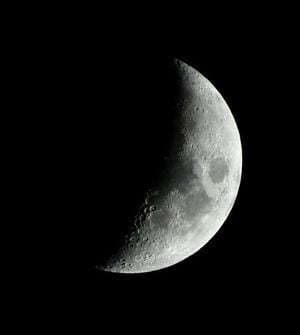Shropshire Sky At Night – January
Most amateur astronomers are familiar with the concept of self-isolation as we spend most of our time observing during antisocial hours.

However, there is nothing more exciting to look forward to than a star party event. These are normally held at a dark site where there is a chance to look through other telescopes, borrow accessories and share our observing successes.
With 2020 curtailing this aspect of our activities alongside the cancellation of regular meetings and outreach work, most societies have turned to online activities, to provide information and advice.
So what can we see this month? Following the major conjunction between Jupiter and Saturn in December both planets will be difficult to spot as they head towards the horizon. However Mercury, the winged messenger, reaches its greatest eastern elongation from the Sun. This means that it is the best time to spot it as it will be at its highest point above the horizon in the evening sky. Look for the planet on the western horizon just after sunset.
Maybe you have just become the owner of a shiny new telescope, and looking forward to discovering many amazing things in the night sky, but DO NOT be tempted to search for Mercury until the Sun is well below the horizon. A better starting point is our nearest neighbour. Being big, bright, starkly bleak, and just a quarter million miles away, the Moon is one celestial object that never fails to impress, even through the most humble of telescopes. Armed with a good Moon map it could keep you busy forever.
The new moon on the 13th provides an opportunity to observe faint objects such as galaxies and star clusters. This is because the Moon is located on the same side of the Earth as the Sun so will not be visible in the night sky, hence there is no moonlight to wash out any dark sky. Half a lunar cycle later the Moon will be located on the opposite side of the Earth as the Sun, hence the 28th will provide us with the first full moon of the year – named by the American tribes as the Wolf Moon. This was due to the hungry wolf packs howling.
The early hours of the 3rd provide the opportunity to view the Quadrantids meteor shower. Unfortunately, a waning gibbous moon will block out most of the faintest meteors. However patience might be rewarded with a few good ones, with the best viewing being from a dark location after midnight. The meteors are produced by dust grains left behind by an extinct comet known as 2003 EH1, which was discovered in 2003. They radiate from the constellation Bootes but can appear anywhere in the sky.
Any comet is better than no comet – where have I heard that before? Well in January comet 2020 M3 (ATLAS) will provide a real challenge. It will not rival the memory of NEOWISE but any comet is good. To try and catch a glimpse of its gaseous glow, sweep the zenith (directly overhead) at about 10.30pm and you might be rewarded.
Steve Szwajkun is a Fellow of the Royal Astronomical Society





